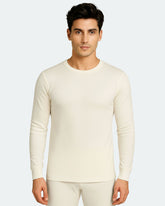Softshell vs Hardshell Jackets: The Ultimate Guide for Winter Treks
In this blog
- Introduction
- Understanding the basics: What are Softshell and Hardshell Jackets?
- Softshell vs Hardshell Jackets: Which one should you choose?
- What to wear on a winter trek?
- How to Layer with Softshells and Hardshells?
- Which Jacket Should you pack for your next trip?
- Winding Up
- FAQs
While packing away for your next escape in the mountains, one often gets stuck on the right outerwear. Amongst a wide range of options, one often gets stuck between Softshell vs Hardshell jackets. While they can look similar, both of them serve very different purposes. So, how do we choose?
Let us help you with that so that your next alpine journey is warm, dry, and memorable for all the right reasons.
 Softshell vs. Hardshell Jackets for Mountain Trekking—Compare Waterproof Performance and Warmth Easily.
Softshell vs. Hardshell Jackets for Mountain Trekking—Compare Waterproof Performance and Warmth Easily.Understanding the Basics: What are Softshell and Hardshell Jackets?
Before we do our best to make our next alpine visit, we should dive into the core and understand what exactly are softshell and hardshell jackets.
Softshell Jackets
Softshell jackets are jackets woven out of stretchy and breathable materials. These jackets are the correct example when functionality meets style. Softshell Jackets are usually made of stretchy and comfortable materials, making them the perfect fit for trekking, in style.
Here are some key features of Softshells:
-
Breathability: These jackets are a popular choice for breathable winter jackets as they don’t lock in moisture and keep the sweat away.
-
Waterproof: These jackets are water repellent, but they aren’t waterproof, thus making them a good fit to consider for a light, cozy trek, but not a good choice for waterproof trekking jackets.
-
Flexibility: Due to their design and the materials used, these jackets are super flexible, combining style with mobility.
Hardshell Jackets
Hardshell Jackets, on the other hand, are made of durable and stiff materials, which protect you from anything, be it the snow, wind, or rain.
Here are some key features of Hardshells:
-
Waterproof: Hardshells are completely waterproof, making them a perfect choice for waterproof trekking jackets.
-
Restrictive: Due to their design and material, hardshells aren’t as breathable as compared to softshells.
-
Best for layering: Hardshells are the best layering jackets for cold, as they keep you warm, and that too in style.
Softshell vs Hardshell Jackets: Which one to choose?
To make the right choice for your next trek, let’s first understand the real difference between Softshell vs. Hardshell jackets.
 Kosha’s Waterproof trekking jackets with wool lining offer superior breathable winter jackets for cold hikes.
Kosha’s Waterproof trekking jackets with wool lining offer superior breathable winter jackets for cold hikes.1. Weather conditions
If you are on a trip where the weather conditions vary from light to moderate cold and dry conditions, stuff the bag with a softshell jacket. It provides better breathing and flexibility.
But if you are planning to explore the snow-covered peaks of Srinagar on a trip, where the weather is extremely cold, wet, or uncertain, a hardshell jacket is your safest choice. The waterproof layer will keep you dry and warm.
2. Softshell vs Hardshell- Which one is the Safer Pick?
To choose between softshell vs hardshell warmth, you need to understand what kind of jacket has been promised when it comes to warmth, comfort, and mobility.
Softshell jackets usually have a fleece-lined interior. Although it provides comfort, flexibility, and breathability to your outfit, it does not work very well in cold or icy climates, unless it is layered with a thermal and a sweater.
Hardshell jackets, on the other hand, are pretty enough in themselves. They protect you from extreme weather conditions, and when paired with other layers, such as a waterproof wool-fleece-lined jacket for men, it gives you the perfect look for your next trek.
To choose between softshell vs hardshell jackets, it is important to know about what weather you will be travelling in, so you can pick out the best option that would strike the balance between warmth, breathability, and mobility.
What to choose for your winter trek?
Now, to understand what might be the right pick for you on a winter trek, you must compare both jackets on certain parameters, and based on the said parameters, you’ll be able to find your perfect pick for your next serene journey in the mountains.
-
Comfort and Fit
Well, the first parameter that one naturally considers while going on a trek, which can sometimes be quite tedious, one naturally prefers functionality over style. In that case, if you prefer mobility over style, softshell jackets might be your go-to choice for your next trek.
Softshell Jackets’ stretchy and breathable design makes them a perfect fit for trekking over hardshell jackets, as they might protect you from the wind or snow, but they’ll hinder your mobility for sure. Thus, softshell jackets win this round, and layering jackets for cold might just protect you from it as well.
-
Breathability Matters!
Everyone has to face great concerns regarding sweat as they trek. When someone sweats in cold weather, it makes them feel even colder because the sweat quickly accumulates, leaving them in an icy position. While keeping this parameter in mind,
Softshell Jackets act as a perfect fit in this, as they excel in moisture management, allowing the sweat to escape, thus keeping you dry.
Whereas Hardshell Jackets, specifically the older models, can trap sweat. However, this isn’t a problem with the newer designs that come with zippers under the arms and the sides, thus allowing the sweat to escape.
If you sweat a lot, you’ll appreciate the breathable winter jackets category. Look for hardshells with vents or choose a softshell for better airflow.
-
Durability and Cost
Hardshell jackets are designed to last. Their hard fabric resists friction from stones, ice, and gear. Because of their design, they are usually more expensive.
Softshell jackets may wear out quickly during strict use, thus making them a cheaper and affordable option.
While picking a jacket, think long term. A durable Hardshell might be the right call if you're trekking often in extreme conditions. But a Softshell can work fine if your adventures happen in milder or more controlled climates. Either way, choosing wool-based layers underneath helps—wool is naturally biodegradable, making it a better choice for you and the planet.

Softshell vs hardshell jackets' durability linked to biodegradation of wool-based waterproof materials.
How to Layer with Softshells and Hardshells?
If you plan on layering softshells and hardshells, then use this simple formula for layering:
-
Base Layer: Wear a moisture-wicking thermal top.
-
Mid Layer: A simple fleece or a puffer jacket might do.
-
Outer Layer: Your choice of either a softshell or a hardshell.
Which Jacket Should you pack for your next trip?
A hardshell jacket is non-pervasive if the walk includes snow, rain, or hard wind. Whereas, a softshell comes in handy in dry but cold areas, offering you the space to breathe.
Want the best of both worlds? Take both. Start the walk in a Softshell and switch to a Hardshell when the weather swings. This combination gives you flexibility and protection all in one.
Still confused? Talk to Kosha’s Winter Wear Specialist through WhatsApp, and browse through Kosha’s winter jackets for men and women to find what suits your trekking style.
 Layering jackets for cold weather helps compare softshell vs hardshell warmth effectively.
Layering jackets for cold weather helps compare softshell vs hardshell warmth effectively.Kosha’s Experts are ready to help!
What sets Kosha apart is its personalized travel styling service. Not sure whether you need a softshell or a hardshell jacket for your next adventure? Kosha’s Winter Wear Specialists are just a message away. Whether you're heading on a winter trek or a skiing trip, they’ll help you choose the right layers based on your destination, duration, and planned activities. Chat with a stylist on WhatsApp—details are available on the website—and build a winter wardrobe that truly works for you.
Connect with our expert, and let them help you- https://w.app/koshatravelwear
Winding Up
While choosing between Softshell vs. Hardshell jackets, there is no one-size-fits-all answer. It comes down to where you go, what season you expect, and how warm and mobile you need to be on that trip.
For the best experience, invest in jackets that complement the entire winter layering system. And remember: relaxation, safety, and breathability are not just properties - they are a necessity.
 Breathable winter jackets like Kosha are ideal for layering jackets in cold climates.
Breathable winter jackets like Kosha are ideal for layering jackets in cold climates.
Explore the curated collection of Kosha for the winter jacket for men and gear up for winter, correctly.
FAQs
1. Which is better for winter treks: Softshell or Hardshell jackets?
It usually depends on the weather and what one is doing. Softshell jackets usually fit dry, cold, and high-activity situations in which they provide breathability and flexibility, while Hardshell jackets are intended for harsher weather conditions like snow, rain, or heavy winds, keeping the wearer waterproof and windproof along the way. Combining both layers is the best option to go for maximum comfort and complete versatility.
2. Are softshell jackets waterproof?
Being water-repellent, softshell jackets aren’t fully waterproof. A softshell might just be able to withstand mild showers or snow, but for heavy rains or wet treks, it would be best to have a hardshell, purposely designed to be a completely waterproof trekking jacket.
3. How do I layer jackets for cold-weather trekking?
An ideal winter layering system contains the following:
Base Layer: Moisture-wicking thermal
Mid-layer: Fleece or puffer
Outer Layer: Depending on the weather, choose a Softshell (for breathability) or a Hardshell. (for waterproofing).
This ensures both warmth and breathability, making it ideal for trekking.
4. Which is more breathable: Softshell or Hardshell jackets?
Softshell jackets are more breathable and ideal for high-intensity activities. Hardshell jackets, although less breathable, with the advent of new models have added features as underarm zips and vents to reduce sweat build-up.
5. Can I use one jacket for all weather conditions?
Although possible, it is not ideal. Softshell jackets work best in dry, cool weather, while hardshell jacket is designed for wet and extremely cold weather. For final preparation, consider carrying and switching based on the weather. Or explore 4-in-1 breathable winter jackets like those from Kosha for adaptable layering.





